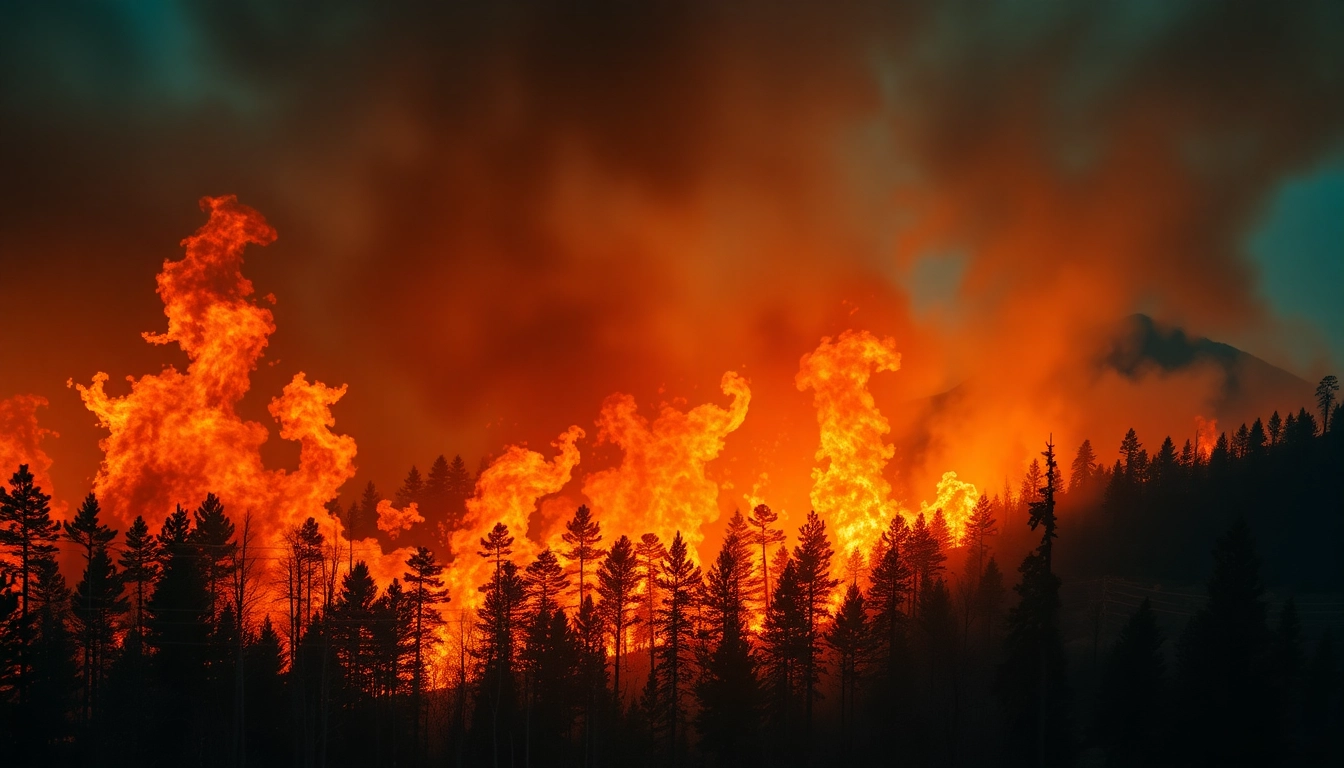Introduction to Wildfire Events
Definition and Overview
Wildfire events refer to uncontrolled fires that burn in wildland areas, including forests, grasslands, and other vegetative landscapes. These fires can vary in size and intensity, ignited by a combination of natural factors and human activities. A wildfire’s progress can be rapid and catastrophic, causing extensive damage to the environment and communities in its path. Understanding these events is crucial for developing effective management strategies, especially as incidents have increased in frequency and severity over recent years.
The essence of wildfire events lies not only in their immediate impact but also in their long-term consequences for ecosystems, economies, and public health. In this article, we explore the intricacies surrounding wildfires, from their causes to their implications and how we can better manage these natural disasters.
The Importance of Wildfire Events
Wildfire events play a paradoxical role in nature. They are often misunderstood as purely destructive forces, but they can also be agents of renewal. Many ecosystems, particularly in regions like the Western United States, depend on wildfires to rejuvenate plant life, control insect and disease populations, and maintain a healthy biodiversity.
Moreover, wildfires have significant implications for land management, urban planning, and environmental policy. Each wildfire event provides valuable data that can inform better practices and strategies aimed at minimizing risks and enhancing community resilience against future incidents.
Common Misconceptions About Wildfires
Despite the wealth of information available, several misconceptions persist about wildfires:
- Wildfires are entirely negative: Although they can cause destruction, many ecosystems actually require fire to thrive.
- All wildfires can be prevented: While many human-induced wildfires can be avoided, natural wildfires are an inherent part of certain ecosystems.
- Firefighters can always control wildfires: Factors like weather, terrain, and vegetation can make control impossible, especially during extreme fire events.
Causes of Wildfire Events
Natural Causes of Wildfires
The most common natural causes of wildfires include lightning strikes, volcanic eruptions, and spontaneous combustion of dry vegetation. Lightning is responsible for a significant portion of wildfires, particularly in remote forested areas, where ignitions can go unnoticed for extended periods. For example, in the United States alone, lightning ignites thousands of fires each year, particularly during the dry summer months.
Human-Related Wildfire Triggers
Human activity is another major contributor to wildfire incidents. Some common human-related triggers include:
- Campfires: Unattended or improperly extinguished campfires can easily spread.
- Discarded Cigarettes: Not surprisingly, improperly disposed tobacco products can ignite plant material.
- Equipment Use: Sparks from machinery or vehicles can ignite dry grass and shrubbery.
- Arson: Deliberate acts of setting fires for various motives have devastating consequences.
The Role of Climate Change
Climate change significantly influences the frequency and intensity of wildfire events. Rising temperatures extend the fire season, increase the drying of vegetation, and create conditions favorable for fire ignition and spread. Regions that experience prolonged droughts are particularly vulnerable, as moisture levels in plants decrease, making them more susceptible to ignition. Furthermore, changes in precipitation patterns can lead to sudden bursts of vegetation growth followed by severe drying, setting the stage for explosive wildfire behavior.
Impact of Wildfire Events
Environmental Consequences
The environmental impact of wildfires can be profound and multifaceted. While wildfires do play a natural role in some ecosystems, the negative effects often outweigh the positives, particularly when they occur near populated areas. Following a wildfire event, ecosystems can suffer from soil erosion, loss of biodiversity, and changes in landscape structure. For example, the aftermath of the 2018 Camp Fire in California left large swathes of the landscape barren, forcing ecosystems to adapt rapidly or risk being lost altogether.
Economic Effects on Communities
Wildfires can have severe economic repercussions for affected communities. These can involve direct costs such as firefighting efforts, emergency response, and property damage. Furthermore, indirect costs can manifest in lost productivity, decreased property values, and increased insurance premiums—all of which can cripple local economies. For example, the economic impacts of the 2020 Australian bushfires were estimated to exceed billions of dollars, highlighting the financial toll wildfires can extract on a community and the resources needed for recovery.
Health Risks Associated with Wildfires
Wildfires pose significant health risks to both firefighters and residents. Exposure to smoke can lead to respiratory issues, cardiovascular diseases, and other serious health conditions. Vulnerable populations, including children, the elderly, and individuals with pre-existing health conditions, face elevated risks. Moreover, the emotional toll of evacuations, property loss, and the aftermath of wildfires can contribute to mental health challenges, making comprehensive health responses critical during and after wildfire events.
Preventing and Managing Wildfire Events
Effective Fire Management Practices
To mitigate the effects of wildfires, effective management practices must be employed:
- Controlled Burns: Professionals can conduct controlled burns to reduce excess vegetation fuel.
- Defensible Space: Property owners should create defensible space around their homes to limit wildfire spread.
- Forest Thinning: Removing excess trees and vegetation can lower fire intensity and provide safe zones for firefighting.
Community Preparedness Strategies
Communities must adopt preparedness strategies to reduce risks associated with wildfires. This includes:
- Public Education: Conducting educational campaigns to increase awareness about fire risks and how to respond.
- Evacuation Plans: Establishing and regularly updating evacuation plans can save lives in emergency situations.
- Community Clean-Up Days: Engaging residents in clean-up initiatives to remove dead vegetation and debris can reduce fire hazards.
Technology’s Role in Wildfire Mitigation
Innovations in technology have the potential to improve wildfire management significantly. Drones equipped with thermal imaging can help detect hotspots in remote areas, while satellite imagery can assist in monitoring fire spread. Additionally, predictive models utilizing big data can inform firefighters about potential fire behavior under varying weather conditions. These technologies offer promising tools for assessment and communication, ultimately improving response times and minimizing damages.
Future of Wildfire Events
Emerging Trends in Wildfire Management
The landscape of wildfire management is evolving, reflecting changes in technology, policy, and community dynamics. One emerging trend is the increased focus on integrating indigenous practices that have historically managed landscapes sustainably. Indigenous knowledge can provide essential insights into fire-dependent ecosystems and effective methods for fostering resilience.
Case Studies of Successful Interventions
Case studies from various locations can provide models for preventing and managing wildfires effectively. One prominent example is California’s use of community-based fire prevention programs that engage local residents in firefighting training and preparedness. These community-driven strategies have led to reduced fire risk and improved safety measures.
Policy Changes and Public Awareness
In response to increasing wildfire threats, many governments are revisiting policies surrounding land use, fire management, and climate change. Raising public awareness about these evolving policies is critical for community engagement and support. Policies that promote sustainable land management and responsible resource use serve as a cornerstone for future wildfire prevention efforts.



